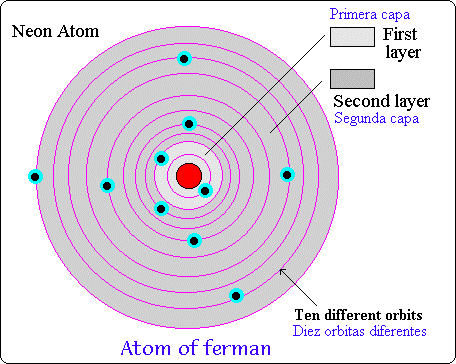Atom of Ferman:
Levels and Density of Energy


For instance, currente quarks 10^-25 grs./ Other calorific particles till 10-^63 gs. / Photons 10-^68 gs about/ sub-atoms till 10^-80 grs.. ( See Particles)
(see Atomic structuring and Atom Structure Drawings)
--Gravity cohere matter and form to the gravitational systems (Atoms, stars, etc.) and
--Magnetism creates orbits and distributes the orbital ones (electrons, planets, etc,) and particles around the nuclei of these systems.
When the gravitational systems rotate on themselves (spin) gravity creates gravitational layers around nucleus, and magnetism creates orbits in which the orbital ones are located.
The gravitational layers are much wider than the magnetic orbits, and therefore, each gravitational layer contains more than one magnetic orbit. 1,1,8,8,18,18....
(In the drawing, the first layer is really formed by two layers, each one with an orbital.)

Magnetism is the force that Cosmos uses to get the middle density of energy in the whole Universe, and therefore in the gravitational systems (atoms, stars, etc.).
Therefore if an atom loses an orbit to give an electron to another atom or to give it to an interior orbit, this atom loses volume and to get the previous density of energy it has to give energy or matter in particles form.
On the contrary sense, if an atom wins an orbit to have acquired an electron of the exterior or to have assimilated it of an interior orbit, in this case this atom has increase its volume and it has to acquire energy from the exterior to be able to arrive another time to its anterior density. Therefore we can say:
"They are not electrons those that emit or receive energy, but atom in whole is that makes this work".
Another erroneous traditional idea is that the change of an electron produces the absorption or emission of a single photon as result.
When an atom changes its volume for loss or acquisition of an orbit, the quantity of energy that is exchanged is much bigger because this energy can be of millions of photons and thousands of bigger particles, always depending of the change circumstances.
** Other topic relative to atom structure as for this treory can be Electrons' Situation